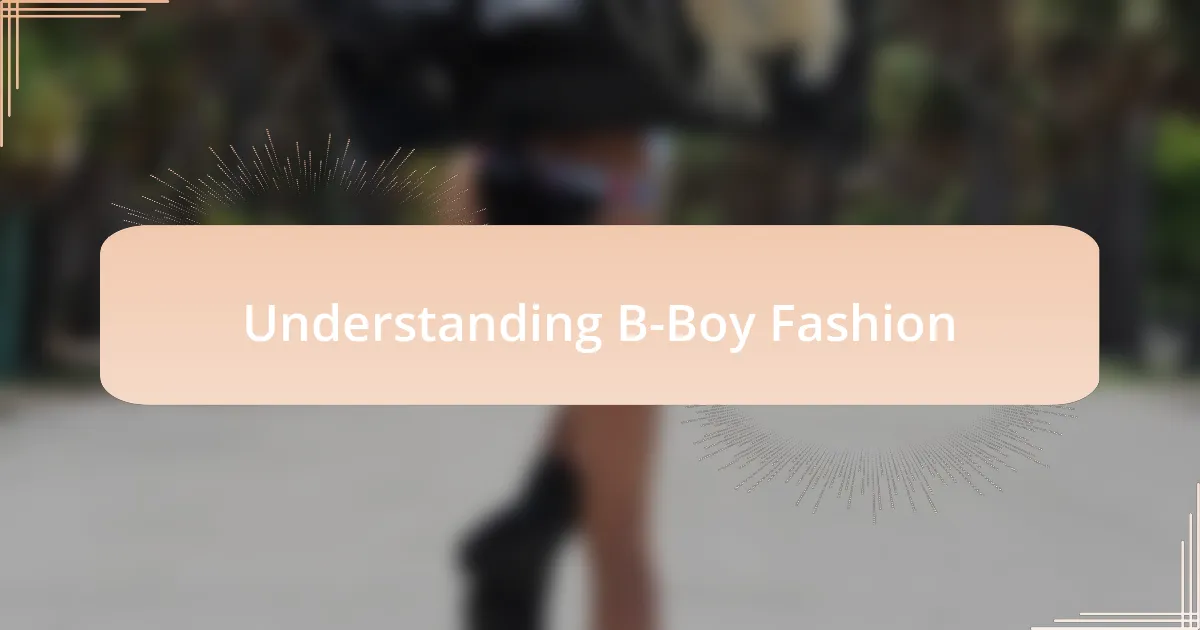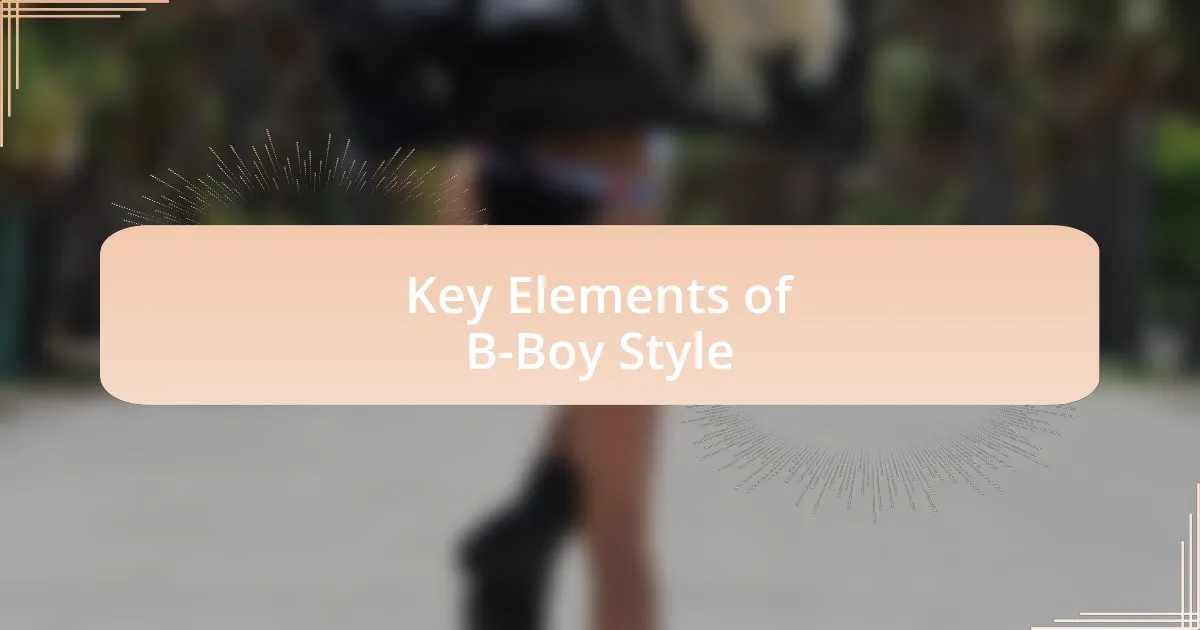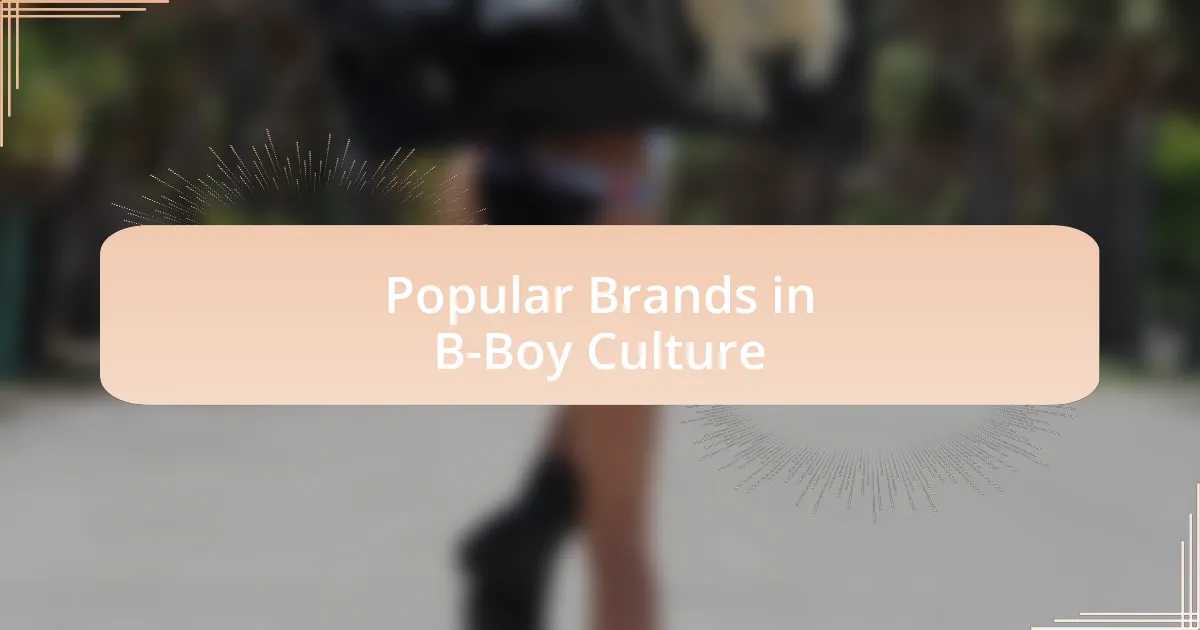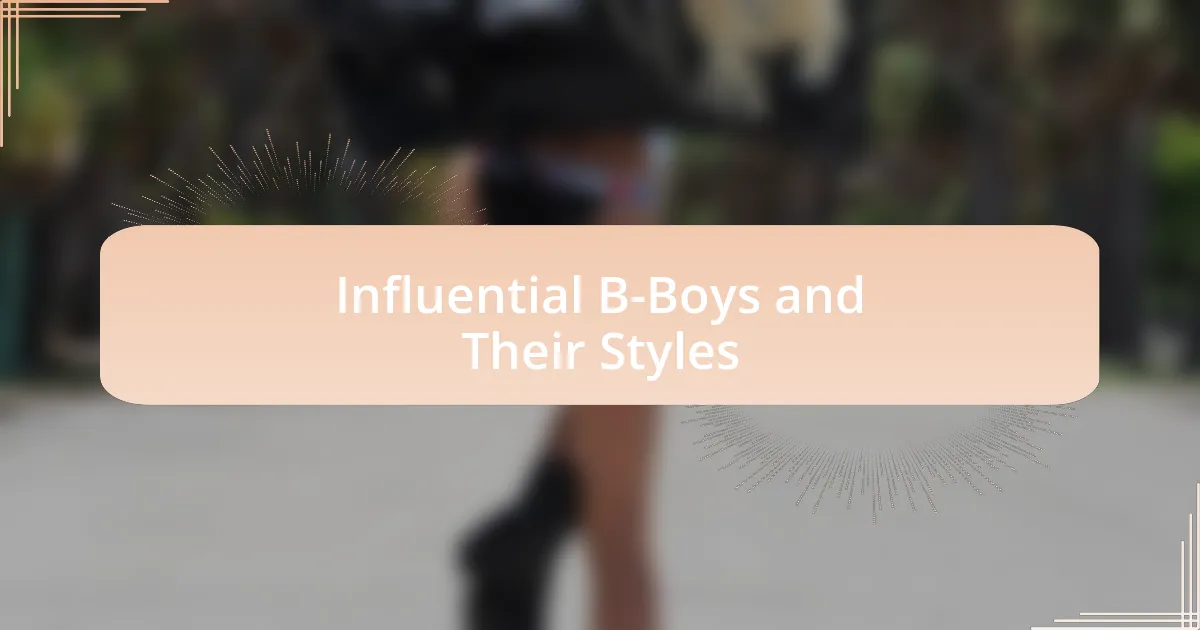Key takeaways:
- B-Boy fashion is a vital expression of individuality and culture, with each clothing piece telling a unique story.
- Fashion serves as a visual language in breakdancing, enhancing a dancer’s confidence and emotional expression during performances.
- Key elements of B-Boy style include comfort, functional footwear, and personal accessories that add flair and identity.
- Influential B-Boys like Crazy Legs and Ken Swift demonstrate how fashion reflects personal style and cultural roots within the dance community.

Understanding B-Boy Fashion
B-Boy fashion is much more than just clothing; it’s a vibrant extension of the culture and a way to express individuality. I remember my first battle—dressed in oversized pants and a colorful tee. I felt invincible, like my outfit made me part of something bigger, a scene that celebrated creativity and self-expression.
When it comes to style, comfort plays a significant role. I’ve seen many dancers prioritize functional pieces that allow for movement and flexibility. Isn’t it fascinating how each piece can tell a story? Whether it’s the classic Air Force 1s or those baggy cargo pants, every item reflects a history of hip-hop and personal taste.
Moreover, color choices and accessories can set the tone for a performance. I once noticed a dancer sporting a bright red bandana that drew everyone’s attention—it added a spark to his moves. What do your clothes say about you when you step onto the floor? It’s these interactions between fashion and identity that really highlight how B-Boy culture thrives on individuality.

Importance of Fashion in Breakdancing
Fashion in breakdancing serves as a visual language that communicates much more than one’s style; it expresses a dancer’s emotions and attitude. I vividly recall a time when a friend of mine sported a vintage windbreaker—its bold patterns reflected his fearless moves. That jacket didn’t just look cool; it brought an extra layer of confidence, making his performance resonate more deeply with the audience. How often do we underestimate the impact of what we wear on our self-assurance?
It’s intriguing to observe how trends evolve within the B-Boy community, with each generation introducing fresh styles that often nod to the past. When I started dancing, there was a distinct revival of throwback brands, which felt like paying homage to those who paved the way. The way we adopt and adapt these influences speaks volumes about how breakdancing is not just an art form but a living, breathing history. Isn’t it amazing how fashion can both connect us to our roots and propel us into new realms of creativity?
Moreover, the competitive aspect of breakdancing can amplify the significance of fashion. I remember attending a battle where one dancer’s flashy sneakers caused quite the buzz among spectators. It’s as if his shoes were a secret weapon, adding flair to every spin and freeze. In that moment, I realized how fashion could elevate performance, turning a great move into a memorable one. Isn’t it fascinating how the right outfit can transform a dancer’s presence on the floor?

Key Elements of B-Boy Style
When I think about key elements of B-Boy style, the first thing that comes to mind is comfort. I remember a time I wore a pair of slightly too-tight jeans during a practice session; let me tell you, it was a disaster! The right fit is crucial; it allows for full mobility and freedom of movement, which is essential when you’re throwing down hard moves.
Another standout feature is the footwear. There’s something about a classic pair of high-tops that makes my heart race. I still have a pair I wore during my first battle—each scuff and scrape is a badge of honor. The right shoes not only enhance your performance, but they also make a statement about your commitment to the culture. Have you ever felt like your sneakers gave you an edge on the dance floor?
Then, there’s the influence of accessories, which are often underrated yet incredibly impactful. Adding items like beanies, snapbacks, or even some flashy wristbands can add personal flair to an outfit, making it distinctly yours. I recall one performance where I wore a vibrant bandana that instantly grabbed attention; it felt like my signature. Isn’t it remarkable how a small detail can become an extension of your identity and boost your confidence?

Popular Brands in B-Boy Culture
When it comes to popular brands in B-Boy culture, a few names stand out due to their unique blend of style and functionality. I’ve always been drawn to brands like Adidas, which not only provides some of the most iconic sneakers but also supports breakdancing events globally. I remember my first pair of classic Shell Toes; they became almost like a second skin during practices. Have you ever felt that connection to your gear?
Another brand that frequently comes up in conversations is Nike. Beyond their stellar athletic shoes, their clothing line resonates with B-Boys because of its emphasis on comfort and aesthetic. I still chuckle at the time I showed up to a jam wearing a Nike tracksuit that was both stylish and easy to move in. You could say it was a hit, and I felt like the best version of myself, ready to battle any challenge.
Then there’s the eclectic vibe of smaller brands like King of the Beat, which perfectly captures the essence of streetwear within B-Boy culture. I recall seeing a crew show up in matching hoodies from this brand, and it struck me how their coordinated look combined with individuality. It’s amazing how the right label can bring a collective energy to the dance floor—don’t you think?

Influential B-Boys and Their Styles
Some of the most influential B-Boys have their unique styles that truly reflect their personalities and backgrounds. Take Crazy Legs, for example. His signature move, the windmill, is matched only by his vibrant fashion choices. I vividly remember watching him dance in baggy jeans and a colorful jersey; he exuded a charisma that made everyone want to emulate his style. Can you recall a B-Boy whose fashion inspired your own?
Another iconic figure is Ken Swift, who is known not just for his technical skills but also for his effortless street style. I once saw him rocking a fitted cap that could have easily turned heads on any city block. It struck me how B-Boy fashion isn’t just about comfort; it’s also about showcasing one’s identity. How do you think your personal style reflects your journey as a B-Boy?
Then there’s the legendary Mr. Wiggles, who blends classic hip-hop elements with a personal touch. I recall seeing him don a flashy bomber jacket coupled with a wide-brimmed hat. His ability to mix styles captures the essence of breakdancing—constantly evolving while holding onto roots. Isn’t it fascinating how much fashion can tell us about a dancer’s journey?

Personal Experiences with B-Boy Fashion
When I first started breaking, my choice of clothing was heavily influenced by the culture around me. I remember going to a local jam, wearing a pair of oversized cargo pants and a fitted tank top. The feeling of the fabric flowing with my movements was liberating, and I couldn’t help but feel like a part of something bigger. Have you ever experienced that moment when the right outfit makes you feel invincible on the dance floor?
As I became more immersed in the community, I learned that fashion is also a way to express who I am outside of dance. For instance, I often paired my warm-up gear with custom sneakers that had my favorite colors. The compliments from fellow dancers made me realize that clothing wasn’t just about looking good; it was a form of connection. Do you have a favorite item that showcases your personality?
Reflecting on the evolution of my style, I now embrace a mix of vintage finds and modern streetwear. I distinctly remember a time when I wore a retro tracksuit to a competition; the nostalgic vibe resonated with the crowd. I felt like I was telling my story through my outfit, contributing to the heritage of our dance while staying true to myself. Does your wardrobe tell a story too?